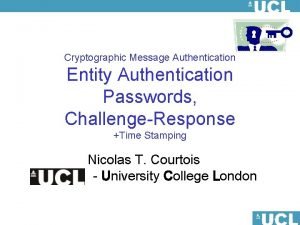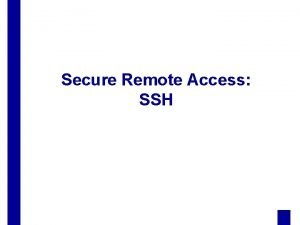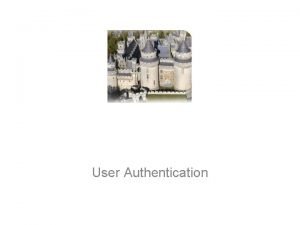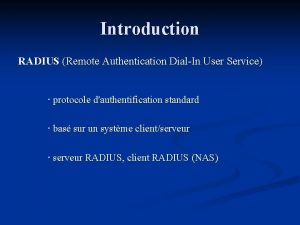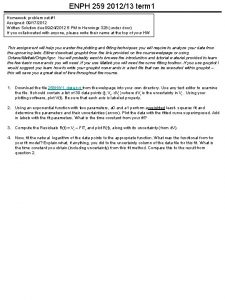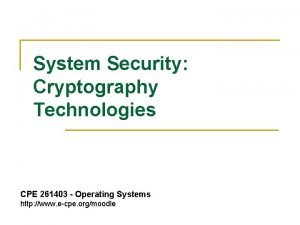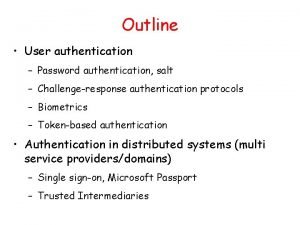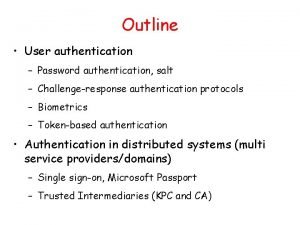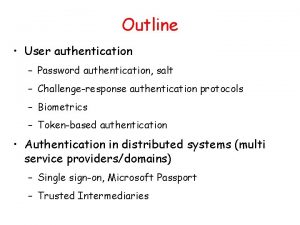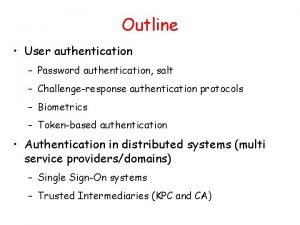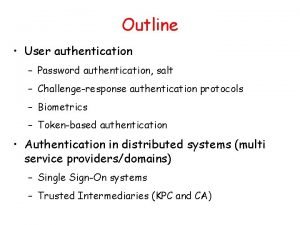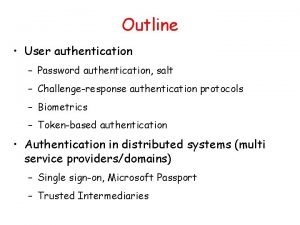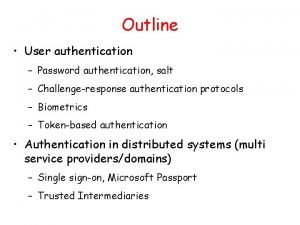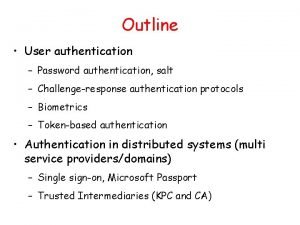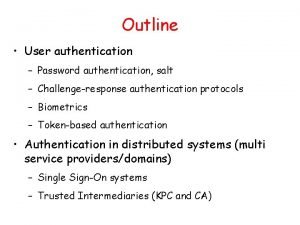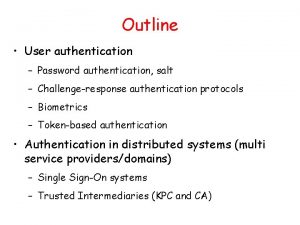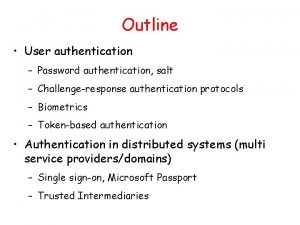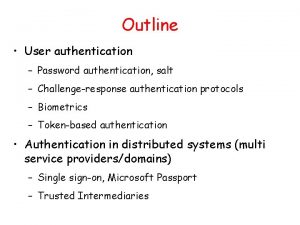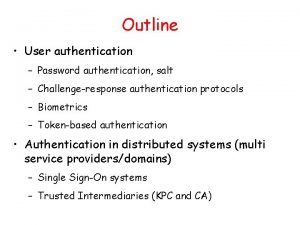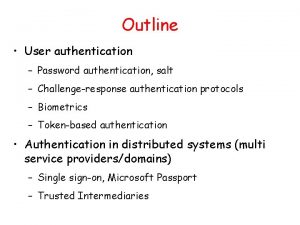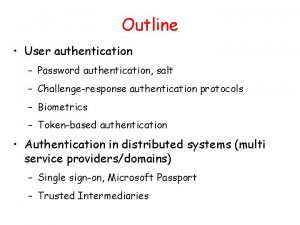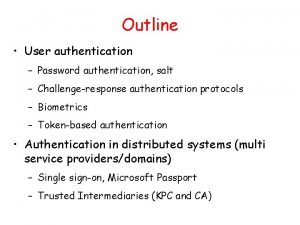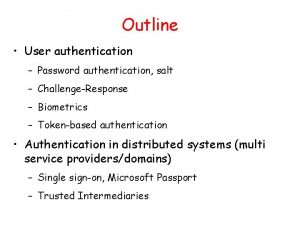CS 259 Password Authentication J Mitchell User Password




















- Slides: 20

CS 259 Password Authentication J. Mitchell

User Password file kiwifruit hash function exrygbzyf kgnosfix ggjoklbsz … …

Basic password authentication u. Setup • User chooses password • Hash of password stored in password file u. Authentication • User logs into system, supplies password • System computes hash, compares to file u. Attacks • Online dictionary attack – Guess passwords and try to log in • Offline dictionary attack – Steal password file, try to find p with hash(p) in file

Dictionary Attack – some numbers u Typical password dictionary • 1, 000 entries of common passwords – people's names, common pet names, and ordinary words. • Suppose you generate and analyze 10 guesses per second – This may be reasonable for a web site; offline is much faster • Dictionary attack in at most 100, 000 seconds = 28 hours, or 14 hours on average u If passwords were random • Assume six-character password – Upper- and lowercase letters, digits, 32 punctuation characters – 689, 869, 781, 056 password combinations. – Exhaustive search requires 1, 093 years on average

Salt u. Unix password line walt: f. URfuu 4. 4 h. Y 0 U: 129: Belgers: /home/walt: /bin/csh Compare Input Constant Plaintext Salt Key 25 x DES Ciphertext When password is set, salt is chosen randomly

Advantages of salt u. Without salt • Same hash functions on all machines – Compute hash of all common strings once – Compare hash file with all known password files u. With salt • One password hashed 212 different ways – Precompute hash file? • Need much larger file to cover all common strings – Dictionary attack on known password file • For each salt found in file, try all common strings

Web Authentication Browser password Server cookie u Problems • Network sniffing • Malicious or weak-security website – Phishing – Common password problem – Pharming – DNS compromise • Malware on client machine next few slides – Spyware – Session hijacking, fabricated transactions

Password Phishing Problem Bank A pwd. A Fake Site u. User cannot reliably identify fake sites u. Captured password can be used at target site

Common Password Problem rit high secu y site pwd. A = pwd. B Bank A low sec urity si te Site B u Phishing attack or break-in at site B reveals pwd at A • • Server-side solutions will not keep pwd safe Solution: Strengthen with client-side support

Defense: Password Hashing k. A ) n a B , d hash(pw A = pwd. A pwd. B Bank A hash(p wd , S B ite. B) Site B u Generate a unique password per site • HMACfido: 123(banka. com) Q 7 a+0 ek. EXb • HMACfido: 123(siteb. com) Oz. X 2+ICiqc u Hashed password is not usable at any other site • Protects against password phishing • Protects against common password problem

Defense: Spy. Block

Defense: Spy. Block Authentication agent communicates through browser agent Authentication agent communicates directly to web site

Spy. Block protection password in trusted client environment better password-based authentication protocols trusted environment confirms site transactions server support required

Goals for password protocol u. Authentication relies on password • User can remember password, use anywhere • No additional client-side certificates, etc. u. Protect against attacks • Network does not carry cleartext passwords • Malicious user cannot do offline dictionary attack • Malicious server (as in phishing) does not learn password from communication with honest user

Simple approach u. Send hashed passwords Browser hash(pwd|0) hash(pwd|1) u. Does this “work”? • Good points? • Bad points? Server

“Interlock” password protocols (Set-up Phase) Password p known to both parties (Key Exchange Phase) A B gx B A gy k = gxy or some function of gxy (Authentication Phase) A B mack(p, r) B A mack(p, s), enck(s) A B enck(r) for random r for random s [Rivest, Shamir, Bellovin, Merrit, … Pederson, Ellison]

ESP-KE key exchange protocol Prime p and generators , β known Generate random a A= a / βP mod p Generate random b B= b mod p A B k = Ba mod p If H(0, k, P) ≠ Mb Abort Ma = H(1, k, P) Mb Ma If A=0 Abort k = (A βP)b mod p Mb=H(0, k, P) If H(1, k, P) ≠ Ma Abort [M Scott]

SRP protocol (Set-up Phase) Carol chooses password P Steve chooses s, computes x = H(s, P) and v = gx (Key Exchange Phase) x = H(s, P) A = ga S = (B - gx) (a+ux) M 1 = H(A, B, S) verify M 2 Key = H(S) C s A B, u M 1 M 2 Bob looks up s, v B = v + gb, random u S = (Avu)b verify M 1 M 2 = H(A, M 1, S) [Wu] Key = H(S)

CMU “Phoolproof” proposal u Eliminates reliance on perfect user behavior u Protects against keyloggers, spyware. u Uses a trusted mobile device to perform mutual authentication with the server password?

 Iff
Iff Peer entity authentication and data origin authentication
Peer entity authentication and data origin authentication Diagbox authentication
Diagbox authentication Secure remote login ssh
Secure remote login ssh Rfc 4949
Rfc 4949 Remote authentication dial-in user service
Remote authentication dial-in user service Enph 259
Enph 259 Descriptive grammar
Descriptive grammar Prairielearn ubc
Prairielearn ubc Sccs library
Sccs library Usd259 portal
Usd259 portal Physics 259
Physics 259 Parentvue usd 259
Parentvue usd 259 Omis 259
Omis 259 Asw-259
Asw-259 User password
User password Inter college passphrase meaning
Inter college passphrase meaning Identified by password
Identified by password Single user and multi user operating system
Single user and multi user operating system Operating systems
Operating systems Mitchell daysh
Mitchell daysh
